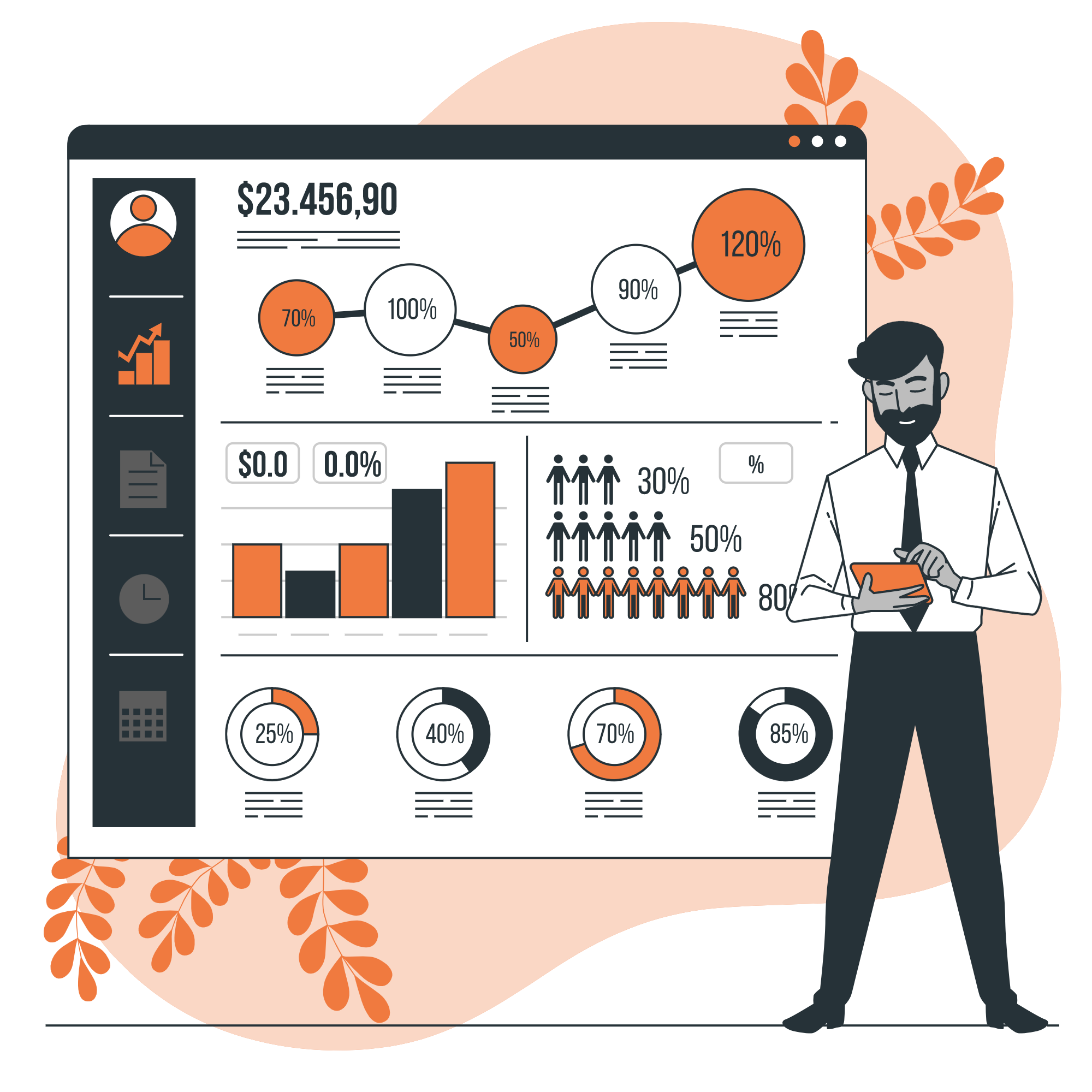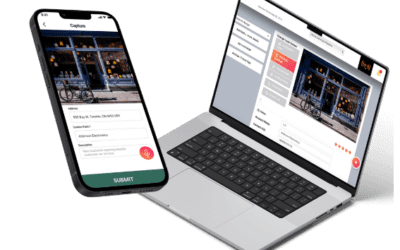Ready to get started?
Your sales pipeline is more like a sales lifeline. Managing it, keeping it flowing, and growing, can be the difference between a successful business that’s projecting healthy growth and a stale business that’s reached a plateau.
Sales Pipeline vs Sales Funnel
Before we begin with sales pipeline management, we need to clarify that a sales pipeline isn’t the same as a sales funnel. Because although you might hear them being used interchangeably, they aren’t quite the same thing.
We’ll break this down in simple terms before diving into the main course:
A sales funnel represents the journey from prospect to customer from the prospect’s point of view. A traditional sales funnel will follow four key stages: awareness, interest, decision, and action.
The reason it’s called a funnel is that there are typically many prospects entering the initial awareness and interest stages of the funnel, but relatively few will turn into paying customers at the action stage. (For more information on what exactly is a sales funnel, check out What Is A Sales Funnel?)
Now, while a funnel is the sales/buying journey from the prospect’s perspective, a sales pipeline reflects the journey from the seller’s point of view.
This is the key difference between a sales funnel and a sales pipeline.
A sales pipeline outlines each stage a prospect goes through as they move from cold prospect to warm customer from the seller’s perspective. A sales pipeline is made up of 5 key stages that help your sales team improve results and refine their effort, namely: lead qualification, scope, proposal, negotiation, and closing.
By clearly identifying and outlining each stage of your sales pipeline, your team will be able to develop better sales processes, predict sales results, assess and remedy sales bottlenecks, and have a clear understanding of how far along every prospect is in the sales pipeline at any given point.
Now that you know the difference between a sales pipeline and a sales funnel, let’s get into how you can manage your pipeline to maximize results.
What is Sales Pipeline Management?
Sales pipeline management is the organization and tracking of prospects, goals, and quotas.
By effectively managing your pipeline, you’re able to maximize the effectiveness of your sales team since you’ll know exactly at what stage of the pipeline any deal is at any given moment, and you’ll know if you’re handling enough deals to meet your quotas or not.
The internal makeup of a sales pipeline consists of 4 areas:
-
- Metrics
- Optimization
- Sales Team Management
- Pipeline Management Tools

Metrics includes data collected during the sales process that can be analyzed by sales teams. Optimization includes aspects like sales forecasting in order to predict sales figures and hit quotas. Sales team management involves progress tracking and regular evaluation of your sales team to ensure everyone is working towards the same goals and making the most of the sales process. And pipeline management tools and applications are designed to help improve your team’s effectiveness and performance.
While it might be easiest and seemingly faster to copy a generic sales pipeline template to implement for your business, we recommend that you closely examine your prospect’s behaviors and patterns so that you can create a sales pipeline that’s perfectly suited to your prospects and customers.
Why is a Sales Pipeline Important?
Because a successful pipeline is a successful business. When your business works to create a healthy sales pipeline, it makes buying your products and services easier. A healthy pipeline also makes it easier for your sales team to close deals, find new ones, and decrease the chances of customers choosing competitors or pulling out of existing deals.
We mentioned earlier that it’s better for businesses to create their own tailored sales pipelines instead of copying templates. Here are some simple steps you can take to build an effective pipeline that fits your business:
1. Start with the buyer journey. This means understanding the steps your customers go through when buying from you. Learning from direct competitors. Learning from market leaders. And working to emulate the successes while eliminating aspects that don’t fit your business.
2. Define and understand your sales cycle. Learn from the leading members of your sales team about their workflows, sequences and playbooks so you can predict and improve how your sales cycle behaves.
3. Set performance goals.
4. Determine performance metrics so you can optimize and refine your sales process in order to hit performance goals.
5. Utilize the best tools and techniques to ensure the best possible chances of success within your team. This includes creating email templates, call scripts, demo videos, and marketing assets that work to bolster the sales team’s process.
As we said in the beginning, a sales pipeline for most businesses is really a sales lifeline. And while no pipeline is ever perfect, paying close attention to different buyer stages, sales cycles and sales team performance helps you dial in your business’s pipeline effectiveness.
More Accurate Forecasting
Now you know the basics of how to build an effective pipeline, what key areas to pay attention to, and what your pipeline should look like. Let’s look into how you can make more accurate forecasting to ensure your pipeline performs with an upward trajectory and improves over time.
Templates for building your pipeline should generally be avoided. However, templates to assist with tracking your pipeline’s performance and current/active contacts help simplify the process of setting up your sales pipeline.
There are plenty of contact tracking templates available. But while most of these are fairly simple and easy to use, they still run the risk of being tedious to fill in, which can bottleneck your team and hinder daily, weekly, or monthly performance.
At Wingmate, our dashboards let you visualize your contact tracking, sales pipeline, and lead qualifications without the need for lengthy, thick spreadsheets.
Dashboards like these make following the customer buying journey much easier, as well as simplify lead tracking, data collection and troubleshooting throughout the sales process.
When looking for a contact tracking solution to implement, the secret is to keep it simple. Speak to your sales team about their processes and find a solution that fits their needs without creating unnecessary complications.

Pipeline Visualization
Having a visual representation of your sales pipeline is a great way to make sure your sales team is staying on track and hitting sales predictions.
It’s also a great way to monitor and track where your team might be losing out on sales or outperforming their targets so that you can make the necessary adjustments to reach your desired results.
Having a visual representation of your pipeline is also a great way to track the overall progress and performance of your sales team over a period of time. This makes planning ahead and adjusting strategies far more effective. And it makes dialing in on weaknesses much easier.
Reporting
Having seamless reporting throughout the sales process helps simplify your sales team’s responsibilities without adding additional work to their day-to-day operations.
As always, no reporting function is ever 100% perfect. But when it comes to reporting being an integrated part of your team’s operations, it doesn’t get much easier than a reporting app.
With reporting apps like Wingmate, your field agents are able to report on potential leads, service issues, and cross-sale opportunities without having to input information into spreadsheets.
This works especially well with frontline team members, and all information gets sent straight to your sales team so they can act on it immediately. This streamlined integration between frontline teammates and your sales reps means that action can be taken in seconds after reporting—shortening the time between finding a qualified lead and moving them through the pipeline.

Email Integration
Your sales team needs to be focused on one thing: Selling.
The more information they have to input into third-party templates, spreadsheets and graphs, the less time they can spend on qualifying prospects and closing leads.
How do you work around data entries? Integration.
The Wingmate app integrates seamlessly with over 2,000 systems, making it a groundbreaking solution in helping sales reps track sales goals, new leads, and lead probability, without the need for cumbersome data inputs.
With email integration, it allows your team to effortlessly switch between platforms without losing track of progress with leads throughout the sales pipeline.
Targeted Resource Allocation
Spreading a team too thinly causes bottlenecks down the road.
Carefully targeting your resources to help your team perform more efficiently and effectively ensures that you can meet long-term goals without having to deal with hindrances to your team’s performance along the way.
By centralizing your team’s resources with a single app, you’re able to cut the fat from your sales pipeline by eliminating unnecessary operations and tasks that would otherwise hinder its performance and effectiveness.
Having a clear sales strategy also improves the likelihood of resources not being wasted through unnecessary friction. To get a better idea of what your sales strategy should look like, consider market-specific variables like the economic climate, geography, and market life cycle within your industry.
Another benefit of a clear sales strategy is that it allows you to reward the top performers while improving the middle and bottom performers. This kind of top-to-bottom approach to sales strategy allows businesses to improve the entire team as a unit instead of working from top, middle, and bottom, one by one.

More Effective Sales Management
Efficiency and effectiveness are key to forging a sales pipeline that consistently hits its goals and improves sales figures quarter after quarter.
Some best practices, which we touched on earlier, that you can implement to start improving your sales management are:
Understanding the numbers.
Tracking your sales metrics lets you know where you’ve been and where you’re going. Specifics, like average won deals, average sales closed vs prospects found, new leads created per month by source, and total number of open opportunities. If sales managers know the averages and specifics of overall sales figures, they’ll be able to better predict future sales, leading to predictable revenue.
Executing regular pipeline reviews.
Pipeline reviews focus on top and middle pipeline performance and are an excellent opportunity to eliminate weaknesses in your sales pipeline. Things like quality of opportunities, greater influence of outcome, and deeper comprehensive views can all be found through thorough pipeline reviews.
Thinking big, but focusing small.
While overall performance and growth are important, focusing small and really dialing in on specific improvements is how you can really influence how your sales pipeline performs. But remember, focusing small isn’t to be confused with micromanaging.
These are just a few ways you can achieve effective sales management. Another way businesses can maximize their sales pipeline is through using a unified platform that’s integrated with a team business-wide.
With a business-wide platform, you can avoid micromanaging and double (or even triple) checking data to ensure accuracy. This improves the efficiency of your sales management, and it helps your sales team work better by removing time spent on inputs.
These kinds of cost-effective solutions also improve communication between field agents, sales reps, sales managers and upped management, further adding value to your sales pipeline and benefiting your prospects’ sales journey through an easy and frictionless sales process.
Increased Deal Velocity
The time it takes to turn someone from being a prospect to a customer is your sales velocity. And your sales team’s ability to shorten/increase their sales velocity can directly influence the health and growth of your sales pipeline.
Here are some approaches you can take to improve your sales velocity:
Involve more lead acquisition channels.
Have a website? Add a chatbot. Have a sales page? Include a blog.
With different lead acquisition channels, you’re able to tap into different pools of prospects that you otherwise would’ve missed.
Optimize your lead outreach.
If prospects prefer speaking on the phone, don’t send emails. If they prefer texting, don’t call. And if they prefer face-to-face chats, don’t send them online meeting invitations. The goal of optimization is to find an outreach channel that works best and use that to maximize sales. Optimization doesn’t always mean cutting down on effort.
Upsell and cross-sell.
If you sell more than one product or service, you can use that to your advantage by upselling and/or cross-selling. Use complementing products together to create a valuable offer for mid-tier buyers through cross-selling. And upsell more expensive products to create better long-term value. Both strategies increase average deal size and can greatly increase sales velocity.
Once you’ve increased your sales deal velocity, you can start looking for ways to increase sales volume (by means of offering different sales incentives, increasing value, or emphasizing customer benefits) which will, in turn, help you hit sales quotas, increase total sales revenue, and continue to improve your sales pipeline.

Sales Pipeline Best Practices
Here’s a quick rundown of some of our top sales pipeline best practices to help you identify improvement opportunities in your pipeline to increase revenue and move more prospects from one stage to the next:
-
-
Follow Up.
Following up on leads is far from easy. And calling a prospect who doesn’t seem interested in buying can be very frustrating. But while the process might be frustrating, the payoff is ultimately rewarding. One way you can improve your follow-up processes are to set reminders that notify you when it’s time to follow up with a prospect.
-
-
-
Optimize the Best Leads.
Following up is important. But sometimes, it’s better to cut your losses by focusing on leads that show real promise. Warm leads can shorten the time it takes to close a sale, and they can become the most valuable customers.
-
-
- Keep an Eye on the Pipeline.
Your sales pipeline changes constantly, so you need to keep an eye on it and watch its fluctuations. Things like the average number of leads, average number of deals, closing ratio, and sales velocity each contribute to pipeline growth—so monitor them and focus on improving in the areas that are lacking.
- Keep an Eye on the Pipeline.
-
- Try Keeping Your Sales Cycle Short.
B2B sales tend to take longer to close than B2C. And with all the options out there, finding an alternative product can be tempting for prospects. The remedy for this is to work on keeping your sales cycle short. Test different methods for follow-ups, emails, and lead generation until you find areas you can cut to shorten your sales cycle.
- Try Keeping Your Sales Cycle Short.
-
- Use a CRM.
Overall healthy pipeline management can be achieved by implementing a simple CRM that manages your prospects through different stages of the pipeline. These systems keep track of your pipeline activities and as well as be able to automate several processes which would otherwise fall on your sales team.
- Use a CRM.
Managing your sales pipeline takes effort, testing, polishing, revising and more effort. It’s not a simple process that can be implemented overnight, but it also doesn’t need to be an overly complicated operation that takes away from other areas of your business.
Think of your sales pipeline as the heartbeat of your business. As long as you’re keeping it healthy and strong, the rest of your business will be able to function better and perform better.
Over 60% of businesses say they do a poor job of managing their sales pipeline, so chances are there are improvements you could be making to your pipeline right now.
With that being said, managing, optimizing and growing your pipeline has never been easier, thanks to modern technology and software tools that work with your team to improve the sales journey of your customers.
Other Articles
Enhancing customer satisfaction with a mobile CRM App
Ready to get started?Are you looking for a way to enhance customer satisfaction in your sales process? Mobile CRM (Customer Relationship Management) apps are the perfect tool to help sales reps stay on top of their customer interactions and keep track of customer...
Lead Management Process
Ready to get started?The lead management process is an important part of any business. It is a method that bridges the gap between marketing and sales which increases the chances of turning prospects into customers and ultimately results in more revenue for your...
Five Key Strategies for Optimizing Field Service Management
Ready to get started?Are you looking for ways to optimize your field service management? If so, you’re in the right place! In this blog post, we’ll explore five key strategies that will help you maximize the efficiency and effectiveness of your field service...




